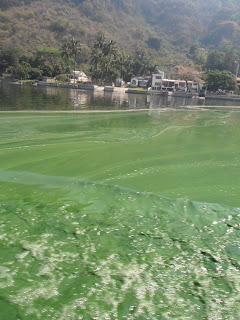 |
| Lago Amatitlan |
 |
| Jarka and Harriet with AMSA staff. |
AMSA, the Amatitlan watershed authority, was very accomidating and showed us around their facilities and then took us out on the lake in one of their boats. We were able to see where they are aerating the lake- trying to alleviate some effects of the harsh eutrophication. We also saw the outflow and inflow rivers, and took many samples for phytoplankton identification. They had the inflow river, which is full of raw sewage, flowing into a settlement pond, which had Eichornia crassipes (water hyacinth) growing in it. Water hyacinth is a weedy, invasive species that is choking out many of the world's waterways. It is a floating species that has an incredible growth rate, but on the other hand is great at removing nutrients (mainly nitrogen and phosphorus) from the water. AMSA was using this species to help decrease the nutrient loads flowing into the lake, but hurricane Agatha rerouted the river, depositing more trash and water hyacinth from the controlled sedimentation pond to the lake itself.
We were then introduced to a couple of Swedes doing work there at Amatitlan with the water hyacinth. They were growing the hyacinth, then collecting the plants (thus removing from the system the nutrients taken up by the plants) and puting them in a biodigester to produce methane for cooking gas. We talked with them for a while and were very glad we made new contacts. Seeing Amatitlan, and all of the pollution flowing into the lake, was a stark reminder of why we are here- to help prevent Atitlan from facing the same fate.
 |
| Water hyacinth sewn together as a flaoting net in the lake to collect garbage coming in from the river. |
 |
| Jiri collecting samples from the sedimentation pond. Water hyacinth is the green floating plant with purple flowers. |

No hay comentarios:
Publicar un comentario